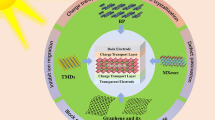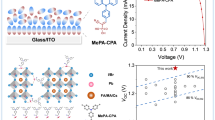Abstract
Formation of bulk heterojunctions by incorporating colloidal quantum dots into a mesoporous substrate is anticipated to yield efficient charge collection and complete light absorption. However, it is still challenging in view of the bulky nature of the colloidal quantum dots and the ex situ deposition route. In this study, the feasibility of employing ZnS as a capping material for PbS quantum dots is dissected by carefully designed control experiments, with reference to the formation of bulk heterojunctions by successive ionic layer adsorption and reaction (SILAR) at ambient conditions. The results reveal that the underlying ZnS layer facilitates the PbS deposition by an ion exchange process, while the overlaying ZnS layer tends to cover the PbS in a manner similar to a physical stacking process. Therefore, PbS quantum dots capped with amorphous ZnS are developed with the SILAR technique, which could be used to fill up the mesoporous substrates and thus construct bulk heterojunctions. The hole collection is the limiting factor of such bulk heterojunction solar cells, as demonstrated by inserting a conductive polymer layer in the control devices. Further development of the quantum dot system is discussed in consideration of the fundamental issues presented in this study.
摘要
将胶体量子点引入到介孔基体中形成体相异质结预期能够产生高效的电荷收集和完全的光吸收. 然而, 鉴于胶体量子点个体体积较大和薄膜异位生长的特性, 形成这样的异质结结构仍然存在巨大挑战. 本论文针对此问题, 通过严谨的实验设计, 分析了采用连续离子层吸附反应法(SILAR)以ZnS作为PbS量子点包覆材料的可行性. 实验结果表明底层ZnS通过离子交换的方式促进PbS的沉积, 而顶层ZnS趋于通过物理堆垛的方式覆盖PbS, 进而形成非晶态ZnS包覆的PbS量子点结构. 该方法可用以填充介孔基体而形成体相异质结结构. 在该体相异质结器件中加入导电有机物的研究表明该体系太阳电池受限于空穴收集. 在此基础上, 讨论了该体系量子点太阳电池进一步提升的途径.
Similar content being viewed by others
References
Nozik AJ. Spectroscopy and hot electron relaxation dynamics in semiconductor quantum wells and quantum dots. Annu Rev Phys Chem, 2001, 52: 193–231
Konstantatos G, Sargent EH. Nanostructured materials for photon detection. Nat Nanotech, 2010, 5: 391–400
Semonin OE, Luther JM, Choi S, et al. Peak external photocurrent quantum efficiency exceeding 100% via MEG in a quantum dot solar cell. Science, 2011, 334: 1530–1533
Yang Z, Voznyy O, Liu M, et al. All-quantum-dot infrared lightemitting diodes. ACS Nano, 2015, 9: 12327–12333
Li C, Lu Z, Zhang Q, et al. Confined growth of CdSe quantum dots in colloidal mesoporous silica for multifunctional nanostructures. Sci China Mater, 2015, 58: 481–489
Hines MA, Scholes GD. Colloidal PbS nanocrystals with size-tunable near-infrared emission: observation of post-synthesis self-narrowing of the particle size distribution. Adv Mater, 2003, 15: 1844–1849
Talapin DV, Murray CB. PbSe nanocrystal solids for n- and p-channel thin film field-effect transistors. Science, 2005, 310: 86–89
Law M, Luther JM, Song Q, et al. Structural, optical, and electrical properties of PbSe nanocrystal solids treated thermally or with simple amines. J Am Chem Soc, 2008, 130: 5974–5985
Luther JM, Law M, Song Q, et al. Structural, optical, and electrical properties of self-assembled films of PbSe nanocrystals treatedwith 1, 2-ethanedithiol. ACS Nano, 2008, 2: 271–280
Graetzel M, Janssen RAJ, Mitzi DB, et al. Materials interface engineering for solution-processed photovoltaics. Nature, 2012, 488: 304–312
Tang J, Kemp KW, Hoogland S, et al. Colloidal-quantum-dot photovoltaics using atomic-ligand passivation. Nat Mater, 2011, 10: 765–771
Ip AH, Thon SM, Hoogland S, et al. Hybrid passivated colloidal quantum dot solids. Nat Nanotech, 2012, 7: 577–582
Ning Z, Voznyy O, Pan J, et al. Air-stable n-type colloidal quantum dot solids. Nat Mater, 2014, 13: 822–828
Lan X, Voznyy O, Kiani A, et al. Passivation using molecular halides increases quantum dot solar cell performance. Adv Mater, 2016, 28: 299–304
Lee JS, Kovalenko MV, Huang J, et al. Band-like transport, high electron mobility and high photoconductivity in all-inorganic nanocrystal arrays. Nat Nanotech, 2011, 6: 348–352
Vogel R, Pohl K, Weller H. Sensitization of highly porous, polycrystalline TiO2 electrodes by quantum sized CdS. Chem Phys Lett, 1990, 174: 241–246
Tian J, Shen T, Liu X, et al. Enhanced performance of PbS-quantum-dot-sensitized solar cells via optimizing precursor solution and electrolytes. Sci Rep, 2016, 6: 23094
Ren F, Li S, He C. Electrolyte for quantum dot-sensitized solar cells assessed with cyclic voltammetry. Sci China Mater, 2015, 58: 490–495
Rühle S, Shalom M, Zaban A. Quantum-dot-sensitized solar cells. Chem Phys Chem, 2010, 11: 2290–2304
Pattantyus-Abraham AG, Kramer IJ, Barkhouse AR, et al. Depleted-heterojunction colloidal quantum dot solar cells. ACS Nano, 2010, 4: 3374–3380
Etgar L, Moehl T, Gabriel S, et al. Light energy conversion by mesoscopic PbS quantum dots/TiO2 heterojunction solar cells. ACS Nano, 2012, 6: 3092–3099
O'Regan B, Graetzel M. A low-cost, high-efficiency solar cell based on dye-sensitized colloidal TiO2 films. Nature, 1991, 353: 737–740
Lee MM, Teuscher J, Miyasaka T, et al. Efficient hybrid solar cells based on meso-superstructured organometal halide perovskites. Science, 2012, 338: 643–647
Barkhouse DAR, Debnath R, Kramer IJ, et al. Depleted bulk heterojunction colloidal quantum dot photovoltaics. Adv Mater, 2011, 23: 3134–3138
Kramer IJ, Zhitomirsky D, Bass JD, et al. Ordered nanopillar structured electrodes for depleted bulk heterojunction colloidal quantum dot solar cells. Adv Mater, 2012, 24: 2315–2319
Lan X, Bai J, Masala S, et al. Self-assembled, nanowire network electrodes for depleted bulk heterojunction solar cells. Adv Mater, 2013, 25: 1769–1773
Sun L, Koh ZY, Wang Q. PbS quantum dots embedded in a ZnS dielectric matrix for bulk heterojunction solar cell applications. Adv Mater, 2013, 25: 4598–4604
Sun L, Wang Q. PbS quantum dots capped with amorphous ZnS for bulk heterojunction solar cells: the solvent effect. ACS Appl Mater Interfaces, 2014, 6: 14239–14246
Sun L, Huang Y, Anower Hossain M, et al. Fabrication of TiO2/CuSCN bulk heterojunctions by profile-controlled electrodeposition. J Electrochem Soc, 2012, 159: D323–D327
Kavan L, Grätzel M. Highly efficient semiconducting TiO2 photoelectrodes prepared by aerosol pyrolysis. Electrochim Acta, 1995, 40: 643–652
Ito S, Murakami TN, Comte P, et al. Fabrication of thin film dye sensitized solar cells with solar to electric power conversion efficiency over 10%. Thin Solid Films, 2008, 516: 4613–4619
Hyun BR, Zhong YW, Bartnik AC, et al. Electron injection from colloidal PbS quantum dots into titanium dioxide nanoparticles. ACS Nano, 2008, 2: 2206–2212
Buhbut S, Itzhakov S, Tauber E, et al. Built-in quantum dot antennas in dye-sensitized solar cells. ACS Nano, 2010, 4: 1293–1298
Williams KJ, Tisdale WA, Leschkies KS, et al. Strong electronic coupling in two-dimensional assemblies of colloidal PbSe quantum dots. ACS Nano, 2009, 3: 1532–1538
Usami A. Theoretical study of application of multiple scattering of light to a dye-sensitized nanocrystalline photoelectrichemical cell. Chem Phys Lett, 1997, 277: 105–108
Nishimura S, Abrams N, Lewis BA, et al. Standing wave enhancement of red absorbance and photocurrent in dye-sensitized titanium dioxide photoelectrodes coupled to photonic crystals. J Am Chem Soc, 2003, 125: 6306–6310
Wolcott A, Doyeux V, Nelson CA, et al. Anomalously large polarization effect responsible for excitonic red shifts in PbSe quantum dot solids. J Phys Chem Lett, 2011, 2: 795–800
Kumar A, Jakhmola A, Chaudhary V. Synthesis and photophysics of colloidal ZnS/PbS/ZnS nanocomposites—an analysis of dynamics of charge carriers. J Photochem Photobio A-Chem, 2009, 208: 195–202
Wright K, Watson GW, Parker SC, et al. Simulation of the structure and stability of sphalerite (ZnS) surfaces. Am Miner, 1998, 83: 141–146
Balantseva E, Berlier G, Camino B, et al. Surface properties of ZnS nanoparticles: a combined DFT and experimental study. J Phys Chem C, 2014, 118: 23853–23862
Mohammad SN. Thermodynamic imbalance, surface energy, and segregation reveal the true origin of nanotube synthesis. Adv Mater, 2012, 24: 1262–1275
El-Ballouli AO, Alarousu E, Bernardi M, et al. Quantum confinement-tunable ultrafast charge transfer at the PbS quantum dot and phenyl-C61-butyric acid methyl ester interface. J Am Chem Soc, 2014, 136: 6952–6959
Sun L, Zhang S, Wang X, et al. A novel parallel configuration of dye-sensitized solar cells with double-sided anodic nanotube arrays. Energy Environ Sci, 2011, 4: 2240–2248
Zhao X, Huang J, Wang Y, et al. Interdigitated CuS/TiO2 nanotube bulk heterojunctions achieved via ion exchange. Electrochim Acta, 2016, 199: 180–186
Lu N, Su Y, Li J, et al. Fabrication of quantum-sized CdS-coated TiO2 nanotube array with efficient photoelectrochemical performance using modified successive ionic layer absorption and reaction (SILAR) method. Sci Bull, 2015, 60: 1281–1286
Author information
Authors and Affiliations
Corresponding author
Additional information
Lidong Sun received his PhD degree in 2012 fromNanyang TechnologicalUniversity, Singapore. Thereafter, heworked as a postdoctoral research fellow at the Department ofMaterials Science and Engineering, National University of Singapore. He is currently an assistant professor at the School of Materials Science and Engineering, Chongqing University. His research interests include the synthesis of nanostructured materials and their application in energy conversion devices.
Rights and permissions
About this article
Cite this article
Sun, L. Employing ZnS as a capping material for PbS quantum dots and bulk heterojunction solar cells. Sci. China Mater. 59, 817–824 (2016). https://doi.org/10.1007/s40843-016-5138-2
Received:
Accepted:
Published:
Issue Date:
DOI: https://doi.org/10.1007/s40843-016-5138-2




